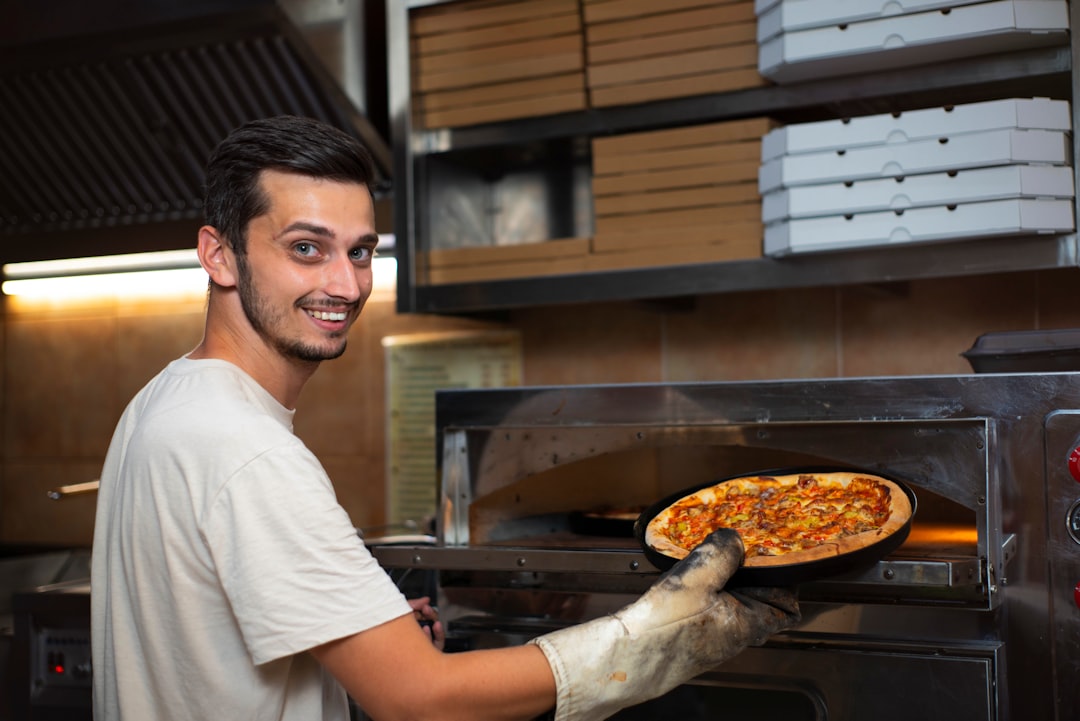
An Essential Guide to Comparing Pizza Pans
Share
The Foundation of a Perfect Pie
Pizza pans are the unsung heroes of every great pizza. The right pan can mean the difference between a soggy, disappointing crust and that perfect golden-brown base that makes customers come back for more.
Types of Pizza Pans:
- Standard/Coupe Pans - Versatile for thin to medium crusts
- Perforated Pans - Create crispy crusts with better air circulation
- Deep-Dish Pans - Essential for Chicago and Detroit styles
- Pizza Screens - Maximum crispiness for commercial operations
Key Materials:
- Aluminum - Lightweight, even heating, rust-proof
- Carbon Steel - Superior heat retention, creates crispy crusts
- Cast Iron - Best browning, requires seasoning
- Stainless Steel - Durable, easy to clean
Your choice of pizza pan directly affects three critical factors: crust texture, cooking time, and overall pizza quality. A perforated aluminum pan will give you a completely different result than a deep-dish steel pan - even with identical dough and toppings.
The material matters just as much as the style. Aluminum conducts heat evenly but doesn't retain it as well as steel. Cast iron creates incredible browning but needs proper seasoning. Each material brings its own advantages to your pizza operation.
My background in restaurant equipment sales has shown me how the right pizza pans can transform a pizzeria's efficiency and product quality.
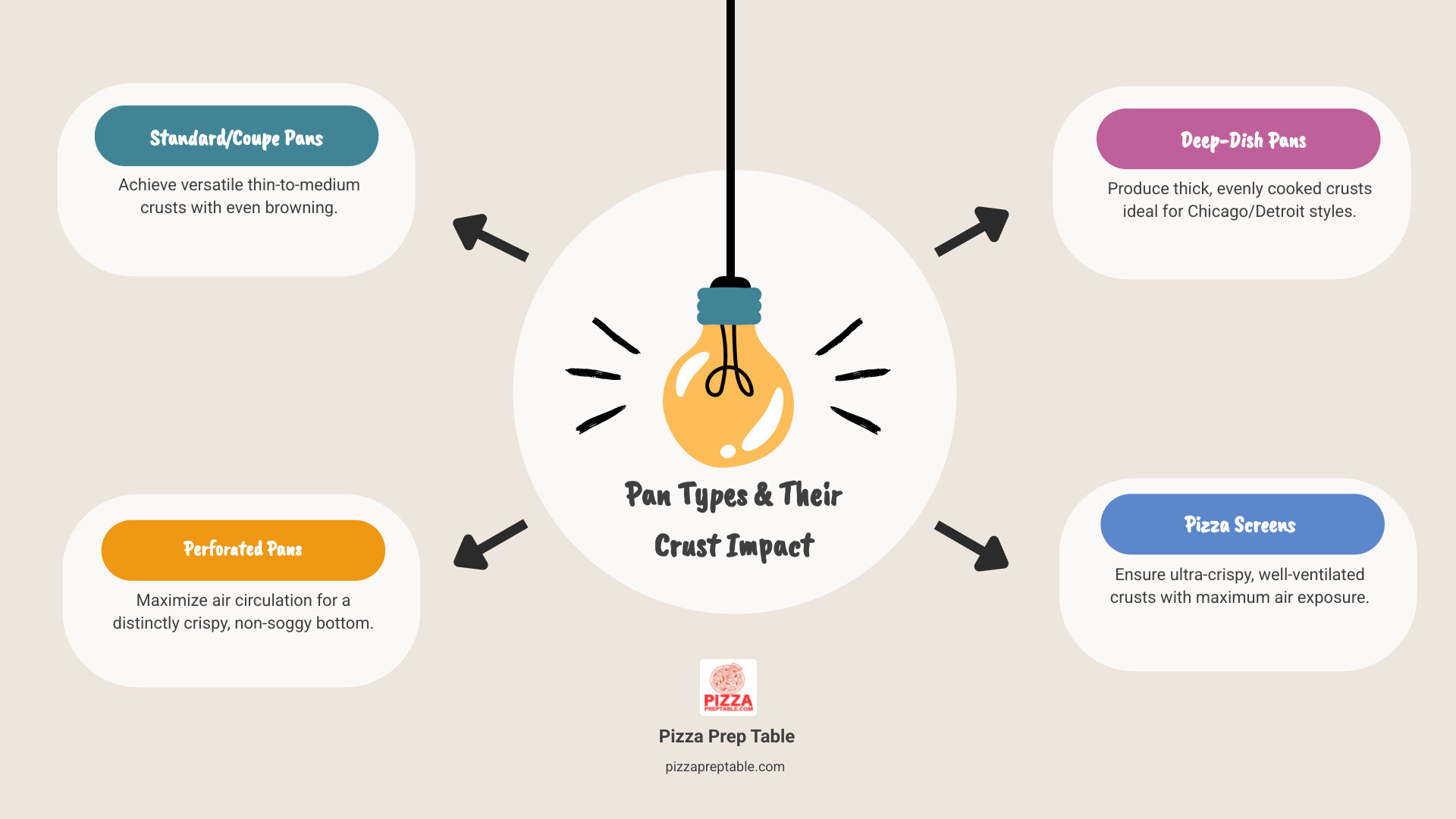
Pan Materials 101: How Metal Affects Your Masterpiece
The material of your pizza pan is crucial. Each metal interacts with heat differently, affecting your crust. Some, like aluminum, heat up quickly and evenly. Others, like cast iron, heat slowly but retain that heat exceptionally well, creating a different texture.
The thickness of your pan matters too. In the restaurant world, this is called "gauge," and lower numbers mean thicker pans. A 14-gauge pan is much heavier and more durable than an 18-gauge pan. Thicker pans distribute heat more evenly, preventing burnt spots. If you want the science behind why pans behave differently, see overviews of thermal conductivity, heat capacity, and how sheet metal gauge is specified.
| Material | Heat Conductivity | Heat Retention | Maintenance | Price Range (Approx.) | Best Crust Type |
|---|---|---|---|---|---|
| Aluminum | Excellent | Moderate | Low | $4 - $25 | Thin, crispy, evenly baked |
| Carbon Steel | Good | Good | Moderate (seasoning) | $10 - $40 | Crispy, well-browned, even bake |
| Stainless Steel | Moderate | Good | Low | $15 - $50 | Evenly cooked, less prone to sticking |
| Cast Iron | Good | Excellent | High (seasoning) | $30 - $80 | Deeply browned, fried-like texture, thick crust |
| Non-Stick Coated | Good (base metal) | Moderate | Low (careful use) | $8 - $30 | Easy release, consistent, less browning |
Aluminum
Aluminum is the most popular material for pizza pans, and for good reason. It's lightweight, making it easy for staff to handle during busy shifts. It heats quickly and evenly, preventing hot spots and ensuring a consistent, golden-brown crust.
Crown Pans and Norjac Pans are household names in the pizza world, offering reliable aluminum options from tiny 9-inch pans ($3.95 CAD) all the way up to massive 17-inch beauties ($11.95 CAD). A standard 12-inch Crown pan runs about $6.10 CAD, while the popular 14-inch size hits around $7.50 CAD.
Aluminum doesn't rust, making it a low-maintenance choice for busy kitchens. You can wash it, stack it, and it's ready for the next service.
Steel (Carbon & Stainless)
Steel pizza pans are durable workhorses. Carbon steel excels at heat retention, creating dark, crispy crusts. It requires seasoning (coating with oil and heat), which builds a natural non-stick surface that improves over time.
VEVOR and Onlyfire make excellent carbon steel pizza steels. A 20" x 14" VEVOR steel runs about $109.99, while Onlyfire's 16 x 14 inch version costs around $75.99. These aren't just pans – they're pizza-making powerhouses with heat conductivity that's 20 times higher than traditional pizza stones.
Stainless steel is a reliable, easy-going option that doesn't need seasoning and resists rust. While it doesn't conduct heat as aggressively as carbon steel, it's incredibly durable and practically maintenance-free. For more insights on why stainless steel dominates commercial kitchens, check out our guide on stainless steel pizza prep tables.
Cast Iron
Cast iron pizza pans are legendary for creating unforgettable crusts with a unique, slightly fried texture. As heat retention champions, they produce deep browning that other materials can't match. The result is a crispy, flavorful crust with distinct character.
Chef Pomodoro offers pre-seasoned 12-inch cast iron pizza pans for $39.99, which means they're ready to go right out of the box. Yes, they're heavier than other options, but the unique crust they create is worth every ounce.
Cast iron does require some TLC. You'll need to season it regularly and dry it thoroughly after washing. But many pizza makers consider this a labor of love. If you're curious about how cast iron stacks up against other popular options, our Cast Iron vs. Pizza Stone: The Grill-Off for Perfect Homemade Pizza guide has all the details.
Non-Stick Coatings
Non-stick coatings on pizza pans, typically applied to an aluminum or carbon steel base, offer effortless pizza release and simple cleanup. This convenience makes them a popular choice.
GoodCook offers a 12-inch nonstick steel pizza pan for just $7.97, while Wilton's 12-inch silver non-stick version runs $23.38. Starfrit The Rock brings their 14.5-inch non-stick pan to the table at $15.97.
The trade-off with non-stick coatings is that they need gentle handling. Metal spatulas and harsh scrubbing can damage the surface. However, modern coatings have improved significantly. Some, like LloydPans' PSTK (Pre-Seasoned Tuff-Kote) finish, are PFAS-free and tough enough to handle metal utensils.
The Ultimate Guide to Types of Pizza Pans
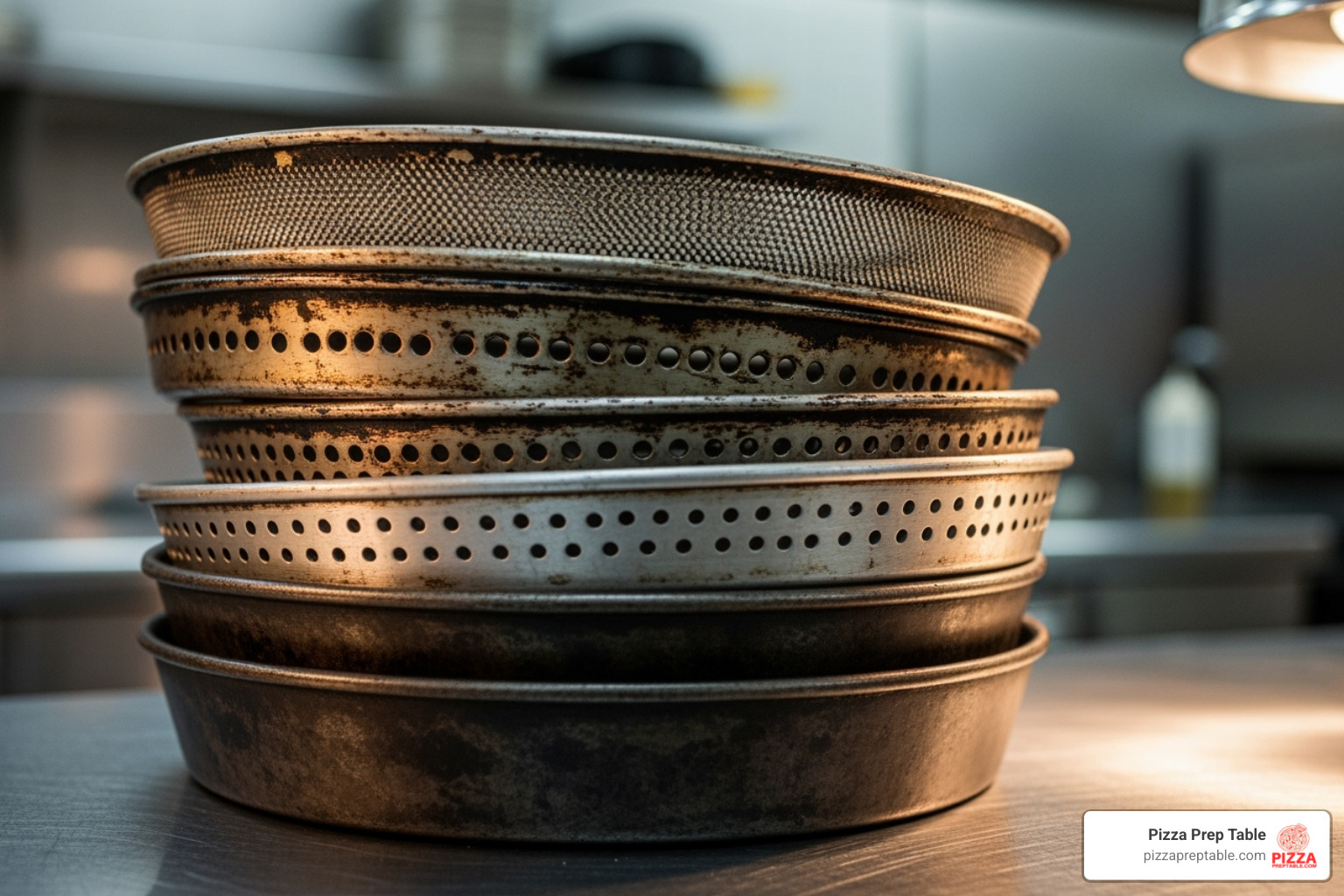
Beyond materials, the design of a pizza pan is key to achieving your desired crust. Each style is crafted for a specific outcome. For example, a rimless coupe style pan creates different results than a deep-dish pan. Perforated pans and pizza screens use airflow to create maximum crispiness.
Pan size and rim type (wide, tapered, or flat) also affect how a pizza bakes and how easily it can be removed from the pan. For busy commercial kitchens, stackable pans are essential for saving space and proofing dough. Crown Cookware's rim stacking pizza pans (1 inch height for $9.00 CAD) are a great example, as they nest for storage and can double as proofing containers.
Standard & Coupe Style Pans
Standard and coupe style pizza pans are versatile workhorses for thin-to-medium crusts. The genius of the coupe pan is its minimal or absent rim. This design allows heat to directly crisp the edges and makes sliding the pizza off for slicing effortless.
American Metalcraft makes some of the most dependable options in this category, like their TP12 12-inch aluminum pan with an 18-gauge construction ($25.15). New Star Foodservice offers great value with their 12-inch coupe style pans, available in 6-packs for $32.86. These pans prove that sometimes the simplest design is the most brilliant.
For the Ultimate Crispy Crust: Perforated Pizza Pans
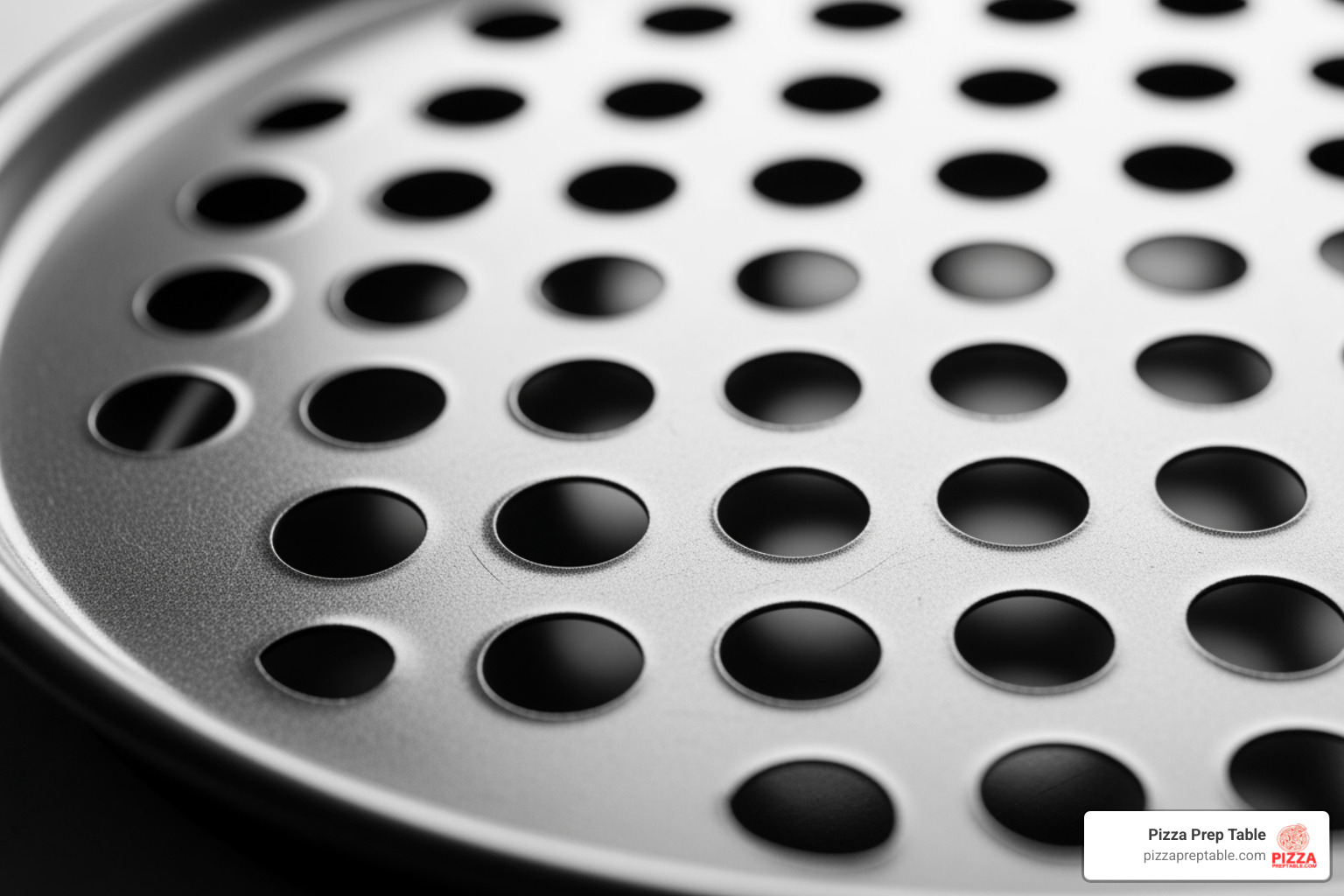
If you've ever had a pizza with a soggy bottom, perforated pizza pans are the solution. These pans have small holes across their surface, allowing hot air to circulate and moisture to escape. The result is a consistently crispy bottom that holds up to heavy toppings. This is especially useful for frozen pizzas or those with high-moisture ingredients.
Crown Cookware offers excellent perforated options in multiple sizes - their 12-inch runs $10.95 CAD, the 14-inch is $12.95 CAD, and you can go all the way up to a 16-inch for $14.95 CAD. HONGBAKE provides nonstick perforated trays in convenient 2-packs for $22.99, perfect for home pizzerias or smaller operations.
The faster baking time is an added bonus that busy kitchens love. When air flows freely around your crust, heat transfer becomes incredibly efficient, often shaving precious minutes off your bake time.
Deep-Dish Pans
When you're crafting a true deep-dish masterpiece, regular pans simply won't cut it. Deep-dish pizza pans feature high sides ranging from 1 to 2.5 inches, creating the perfect vessel for those gloriously thick, loaded pies that define Chicago and Detroit styles.
These aren't just taller pans - they're engineered differently. The sides often have a subtle taper that makes removing your finished pizza much easier and allows empty pans to nest together for storage. The extra depth ensures your thick crust cooks evenly all the way through, preventing that dreaded raw center.
LloydPans leads the commercial market with their precision-engineered deep-dish options. You can explore their full range of Commercial Pizza Pans to see the professional-grade quality that pizzerias depend on. For home use, Chicago Metallic offers their Professional Non-Stick Deep Dish Pizza Pan (14.25-inch for $17.50) that brings commercial performance to your kitchen.
The material choice becomes even more critical with deep-dish pans. Hard-anodized aluminum and seasoned steel excel here because they retain heat beautifully, ensuring your thick crust develops that perfect golden-brown color. If you want to dive deeper into this iconic style, check out our complete guide to Chicago Pizza.
Pizza Screens & Disks
For the ultimate in crispy perfection, especially in high-volume commercial kitchens, pizza screens and disks take air circulation to its absolute maximum. These mesh or heavily perforated tools offer minimal barrier between your dough and the oven's heat.
Pizza screens are made from fine aluminum mesh that allows hot air to reach virtually every square millimeter of your crust. This creates an incredibly crispy texture that's perfect for thin-crust pizzas or any situation where you need lightning-fast baking times. They're particularly popular in commercial conveyor ovens where speed and consistency are everything.
Norjac makes reliable aluminum mesh screens in popular sizes - their 14-inch 2-pack runs $29.95, while the 12-inch version is $24.95. American Metalcraft offers larger options like their 20-inch screen for $22.99, perfect for family-sized pizzas.
Pizza disks work similarly but feature a solid surface with heavy perforation rather than mesh. Both styles excel at pre-baking crusts and work beautifully in high-temperature commercial environments.
These tools are essential in busy pizzerias where every second counts and crust consistency can make or break your reputation. If you're planning a commercial operation, understanding how these tools work with high-capacity ovens is crucial. Learn more about creating the perfect baking environment in our guide to Commercial Pizza Ovens That'll Make Your Dough Rise (Literally).
Matching the Pan to the Pie: A Style-by-Style Breakdown
The beauty of pizza lies in its incredible diversity. Each regional style tells a story through its crust, toppings, and baking method. To truly honor these traditions and create authentic results, you need to understand how different pizza pans work with specific pizza styles.
Think about it this way: a New York slice needs to fold without breaking, while a Chicago deep-dish needs to hold layers of cheese and chunky sauce. The pan you choose directly affects the dough's hydration behavior, how the weight of toppings is supported, and how heat transfers during baking.
New York Style
Nothing beats the satisfaction of a proper New York slice - that perfect balance of thin yet sturdy crust that can hold generous toppings while still folding cleanly in half. The secret to achieving this iconic texture lies in choosing pans that promote quick, direct heat transfer and accommodate the pizza's impressive size.
Pizza screens are absolutely fantastic for New York style because they allow maximum airflow around the crust, creating that signature crispy bottom without overcooking the top. The mesh design lets moisture escape quickly, preventing any sogginess that could ruin the fold test.
Standard aluminum coupe pans are another excellent choice, especially those with minimal or no rim. The low profile allows the crust edges to develop that slightly charred, crispy texture that New Yorkers love. Plus, the rimless design makes it incredibly easy to slide the finished pizza off for slicing - no wrestling with high sides.
Size matters here too. New York pizzas are known for being generous, so look for pans in the 16-inch range or larger. The larger surface area helps achieve that classic thin stretch without tearing the dough. For the complete story on this beloved style, dive into our guide on New York Style Pizza.
Chicago Deep-Dish
Chicago deep-dish is pizza's answer to comfort food - a thick, buttery, biscuit-like crust that cradles layers of cheese, chunky sausage, and robust tomato sauce. This isn't just pizza; it's architecture, and it demands a pan that can handle the engineering challenge.
The depth is absolutely non-negotiable here. You need pans that are 1.5 to 2 inches deep to contain all those glorious layers while ensuring the thick dough cooks evenly from bottom to top. Shallow pans simply won't cut it - you'll end up with overflow and uneven cooking.
Material choice becomes critical with deep-dish. Seasoned steel and aluminum pans are the go-to options because they retain and distribute heat effectively. This sustained heat transfer is essential for cooking through that substantial crust without burning the outside.
A well-seasoned or non-stick surface is your best friend when it comes time to remove these hefty pies. With all that cheese and thick dough, you want the pizza to release cleanly without leaving half your masterpiece stuck to the pan.
Chicago Metallic has built their reputation on understanding this style perfectly. Their Deep Dish Pans are engineered specifically for achieving that authentic Chicago experience.
Detroit Style
Detroit-style pizza is the underdog that's finally getting its due recognition. This rectangular marvel features a thick, airy, focaccia-like crust with those incredible crispy, caramelized "frico" cheese edges that have pizza lovers everywhere swooning. The magic happens entirely because of the specialized pan.
Rectangular pans are essential - there's no workaround here. Traditional Detroit pans feature slightly angled sides (around 76 degrees) that make it easier to remove the finished pizza and allow empty pans to nest together for storage. Common sizes like 8x10 inches give you that authentic proportion.
The material story is fascinating. Originally, Detroit pizzerias used repurposed blue steel automotive parts pans, which gave the pizza its distinctive characteristics. Today, hard-anodized aluminum pans with specialized coatings like LloydPans' PSTK finish have become the professional standard. These modern pans deliver the same performance with better durability and easier maintenance.
Dark finishes are crucial for Detroit style because they absorb and radiate more heat, creating those coveted caramelized edges where the cheese meets the pan sides. This extra heat creates the "frico" - those crispy, lacy cheese edges that make Detroit pizza so addictive.
Central Milling offers an excellent Detroit Style Pizza Pan (8x10) that captures all these essential features, helping you create that authentic Motor City experience in your own kitchen.
Care, Maintenance, and FAQs for Your Pizza Pans
Taking care of your pizza pans isn't just about keeping them clean – it's about protecting your investment and ensuring every pizza comes out perfectly. Think of it like maintaining a good cast iron skillet or your favorite knife. With the right care, these pans will serve you faithfully for years to come.
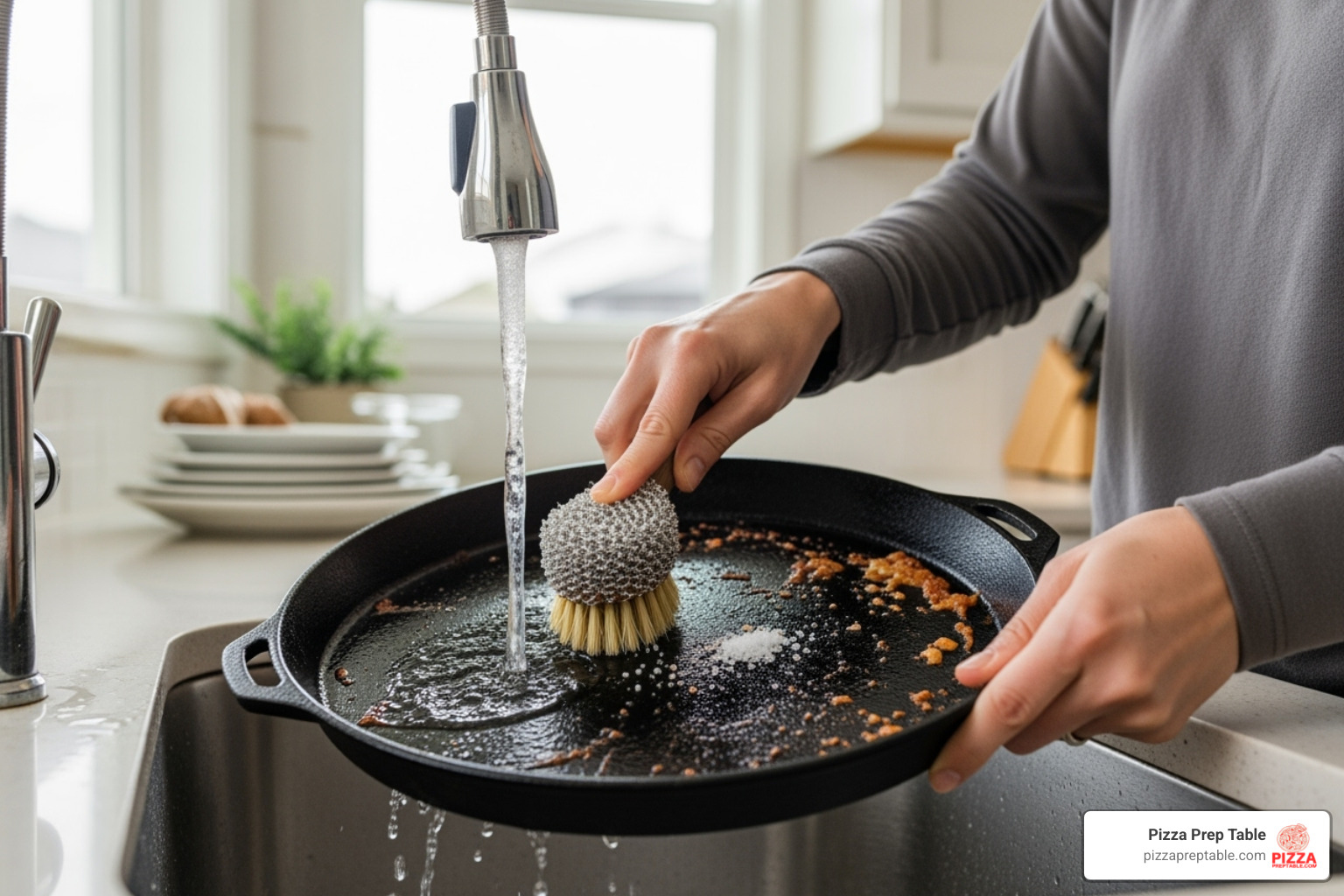
The golden rule of pan maintenance is simple: different materials need different love. What works perfectly for your aluminum pan could completely ruin a seasoned cast iron one. Let me walk you through the best practices for each type.
How should I clean and maintain my pizza pans?
Your cleaning routine should match your pan's personality. Aluminum pans are the easy-going friends of the pizza world – they're forgiving and straightforward. Wash them with warm, soapy water and a soft sponge, just like you would any regular dish. The key is avoiding anything abrasive that might scratch the surface. If you've got some stubborn cheese or sauce stuck on there, let the pan soak in hot water for a few minutes first.
Here's where aluminum gets picky though: always dry it thoroughly right after washing. Water spots aren't just cosmetic – they can affect how evenly your pan heats up. The good news? Aluminum won't rust, so you don't have to stress about a little moisture like you would with steel.
Seasoned steel and cast iron pans are the high-maintenance performers of the group, but they reward your extra effort with incredible results. Never, and I mean never, use soap on these beauties. Soap strips away that precious seasoning layer you've worked so hard to build up. Instead, scrape off any food bits with a plastic scraper or stiff brush, then rinse with hot water.
For really stubborn spots, grab some coarse salt and use it as a natural abrasive. After cleaning, dry your pan completely – I like to put it on the stovetop over low heat for a minute or two to make sure every drop of moisture is gone. Then apply a thin layer of cooking oil while it's still warm. This keeps the seasoning strong and prevents rust.
Non-stick coated pans are the low-maintenance superstars. Warm soapy water and a soft cloth are all you need. But treat that coating like the delicate surface it is – no metal utensils, no abrasive scrubbers, and definitely no harsh detergents. Even if the manufacturer says it's dishwasher safe, hand washing will help that coating last much longer.
Perforated pans and pizza screens need a little extra attention because of all those holes. Use a brush to get into every perforation and make sure no food particles are hiding out. A good soak can work wonders for stubborn bits. Just remember to dry them completely – trapped moisture in those holes can lead to rust spots.
Storage matters too. Make sure everything is bone dry before you stack your pans. If you're stacking regularly, consider using pan separators to protect the surfaces and allow air to circulate.
What's the difference between home use and commercial pizza pans?
The difference between home and commercial pizza pans is like comparing a family sedan to a delivery truck – both get the job done, but one's built for much heavier use. Commercial pans are the workhorses of the pizza world, designed to handle the daily grind of a busy kitchen.
Durability is the biggest difference. Commercial pans use heavier-gauge materials – think 14-gauge aluminum that can take a beating day after day. They're built to withstand constant high heat, frequent washing, and the inevitable bumps and drops that happen in a restaurant environment. Home pans can be lighter and thinner because they don't need to survive that kind of punishment.
Size options expand dramatically in the commercial world. While home pans typically max out around 16 inches, commercial operations might need 18-20 inch monsters or specific rectangular dimensions for high-volume production. It's all about efficiency and meeting customer demand.
Stacking features become crucial when you're dealing with limited kitchen space and need to proof dozens of dough balls. Commercial pans often have tapered sides or special rim designs that let them nest together perfectly. Crown Cookware's Rim Stacking Pizza Pans (1 Inch Height, Made in Canada for $9.00 CAD) are a perfect example – they're designed to maximize storage and workflow efficiency.
The materials and coatings in commercial pans prioritize performance and longevity over convenience. You'll find hard-anodized aluminum and pre-seasoned steel with robust coatings like LloydPans' PSTK, which can even handle metal utensils. Home pans might focus more on easy cleanup and attractive appearance.
At Pizza Prep Table, we see this difference every day. Professional kitchens need equipment that won't let them down during the dinner rush. That's why we emphasize investing in commercial-grade equipment that can keep pace with demand. For more insights on building an efficient operation, check out The Secret Sauce Behind Efficient Pizza Prep Stations.
How much do pizza pans cost?
The price range for pizza pans is surprisingly wide, and understanding what drives those costs can help you make the best choice for your needs and budget.
Budget-friendly aluminum pans are where most people start, and honestly, they're fantastic value. You can grab a basic 9-inch Crown pan for just $3.95 CAD, or step up to a 16-inch perforated version for $12.95 CAD. Some traditional solid pizza pans "Made in Canada" start as low as $3.00. These aren't fancy, but they'll turn out great pizzas and are perfect for getting started or handling basic needs.
Mid-range options typically fall between $10-$30 and include pans with special features like non-stick coatings or perforations. A GoodCook Everyday Nonstick Steel Pizza Pan (12-inch) runs about $7.97, while a Bekith 3-pack of perforated trays costs $19.99. This range gives you better performance features without breaking the bank.
Premium pans start around $35 and can easily exceed $100, especially for specialized materials like cast iron or high-performance steel. A Chef Pomodoro Cast Iron Pizza Pan (12-inch) costs $39.99, while a LloydPans Detroit Style Pizza Pan (10x14 inch) is $41.05. Premium pizza steels can reach $75-$110 or more.
Here's the thing about price: the cheapest option isn't always the best value. A $40 cast iron pan that lasts decades and improves with age might be a better investment than replacing $10 pans every few years. Consider how often you'll use it, what results you're after, and how long you want it to last.
The sweet spot for most serious home pizza makers falls in that $15-$40 range, where you get quality construction and useful features without paying for commercial-grade durability you might not need.
Conclusion: Choose the Right Pan for Your Perfect Pizza
After diving deep into pizza pans, one thing becomes crystal clear: the pan you choose isn't just about holding your dough – it's about changing it into something extraordinary.
Think about everything we've covered together. The material of your pan determines whether you'll get aluminum's quick, even heating or cast iron's incredible browning power. The type of pan you select – whether it's perforated for that perfect crisp or deep-dish for Chicago-style magic – directly shapes your crust's final texture and character.
We've seen how a simple choice between a standard aluminum pan and a perforated screen can mean the difference between a soggy bottom and that satisfying crunch. How the right deep-dish pan isn't just helpful for Detroit-style pizza – it's absolutely essential. Even details like rim design affect how easily you can slide your masterpiece onto a cutting board.
Your pizza pan is truly an extension of your craft. Whether you're perfecting weekend pies at home or running a busy pizzeria, the right pan lifts everything. It affects your crust texture, speeds up your baking time, and ultimately determines whether your customers take that first bite and smile.
At Pizza Prep Table, we've seen how the right equipment transforms not just individual pizzas, but entire businesses. Quality pizza pans are an investment that pays dividends in every slice you serve. They're the foundation that lets your skills, your recipes, and your passion truly shine through.
When you're ready to take your pizza game to the next level, great pizza starts with great equipment. Explore our full range of professional pizza prep tables and supplies and find how the right tools can make all the difference in your kitchen.

